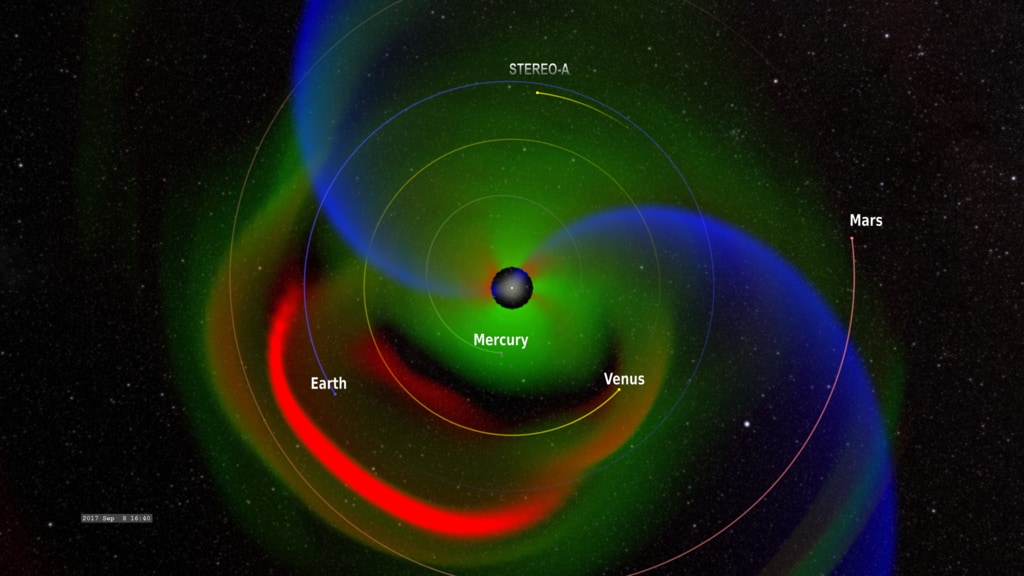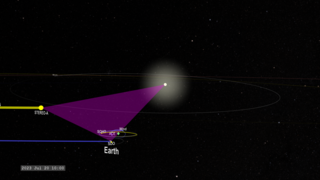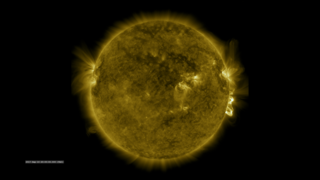Sun
ID: 4699
Energetic events at the Sun can reverberate around the solar system.
This visualization combines data from particle detectors around the solar system with an Enlil simulation of multiple coronal mass ejections (CMEs) in early September 2017. The Enlil model extends from 0.1 astronomical units (AUs) from the Sun (this is reponsible for the empty region around the Sun at the center of the system) out to 5 AUs.
Stream Interaction Regions (SIRs) are created by the interaction at boundaries between the fast and slow solar wind (usually defined by coronal holes). In this model, they are represented by blue spirals streaming out from the sun at the center.
Active Region 12673 erupted with several X-class flares and CMEs on September 9-10, 2017. The initial CME was slow (500 km/s) and the subsequent CMEs were faster (1000 km/s and 2600 km/s, respectively). Eventually the CMEs merged together and continued outward.
At Earth, the particle detector on GOES detects the initial flare. The energetic proton flux decays with time and has a sharper decrease as the CME and SIR pass Earth.
The initial flare is also detected at Mars by Mars EXpress, after which the flux declines. The flux experiences an additional sharp drop as the CME passes Mars.
There is a small flux increase at STEREO-A at the time of the flare. However, the flux increases dramatically as the SIR passes, then slowly decays.



The CME Heard 'Round the Solar System
This visualization combines data from particle detectors around the solar system with an Enlil simulation of multiple coronal mass ejections (CMEs) in early September 2017. The Enlil model extends from 0.1 astronomical units (AUs) from the Sun (this is reponsible for the empty region around the Sun at the center of the system) out to 5 AUs.
Stream Interaction Regions (SIRs) are created by the interaction at boundaries between the fast and slow solar wind (usually defined by coronal holes). In this model, they are represented by blue spirals streaming out from the sun at the center.
Active Region 12673 erupted with several X-class flares and CMEs on September 9-10, 2017. The initial CME was slow (500 km/s) and the subsequent CMEs were faster (1000 km/s and 2600 km/s, respectively). Eventually the CMEs merged together and continued outward.
At Earth, the particle detector on GOES detects the initial flare. The energetic proton flux decays with time and has a sharper decrease as the CME and SIR pass Earth.
The initial flare is also detected at Mars by Mars EXpress, after which the flux declines. The flux experiences an additional sharp drop as the CME passes Mars.
There is a small flux increase at STEREO-A at the time of the flare. However, the flux increases dramatically as the SIR passes, then slowly decays.



Used Elsewhere In
Related
Visualization Credits
Tom Bridgman (Global Science and Technology, Inc.): Lead Visualizer
M. Leila Mays (NASA/GSFC): Scientist
Mara Johnson-Groh (Wyle Information Systems): Lead Writer
Laurence Schuler (ADNET Systems, Inc.): Technical Support
Ian Jones (ADNET Systems, Inc.): Technical Support
M. Leila Mays (NASA/GSFC): Scientist
Mara Johnson-Groh (Wyle Information Systems): Lead Writer
Laurence Schuler (ADNET Systems, Inc.): Technical Support
Ian Jones (ADNET Systems, Inc.): Technical Support
Please give credit for this item to:
NASA's Goddard Space Flight Center Scientific Visualization Studio and the Community-Coordinated Modeling Center (CCMC), Enlil and Dusan Odstrcil (GMU).
NASA's Goddard Space Flight Center Scientific Visualization Studio and the Community-Coordinated Modeling Center (CCMC), Enlil and Dusan Odstrcil (GMU).
Science Paper:
Modeling the Evolution and Propagation of 10 September 2017 CMEs and SEPs Arriving at Mars Constrained by Remote Sensing and In Situ Measurement
Short URL to share this page:
https://svs.gsfc.nasa.gov/4699
Missions:
GOES-R
Mars Express
STEREO
Data Used:
Note: While we identify the data sets used in these visualizations, we do not store any further details nor the data sets themselves on our site.
This item is part of this series:
Studies of the September 2017 Flares and CMEs
Keywords:
SVS >> Mars
SVS >> Solar Wind
SVS >> Space Weather
SVS >> Hyperwall
SVS >> GOES
SVS >> Heliophysics
SVS >> STEREO
SVS >> Corona
NASA Science >> Sun
GCMD >> Earth Science >> Sun-earth Interactions >> Solar Activity >> Coronal Mass Ejections
GCMD >> Earth Science >> Sun-earth Interactions >> Solar Energetic Particle Flux
GCMD keywords can be found on the Internet with the following citation: Olsen, L.M., G. Major, K. Shein, J. Scialdone, S. Ritz, T. Stevens, M. Morahan, A. Aleman, R. Vogel, S. Leicester, H. Weir, M. Meaux, S. Grebas, C.Solomon, M. Holland, T. Northcutt, R. A. Restrepo, R. Bilodeau, 2013. NASA/Global Change Master Directory (GCMD) Earth Science Keywords. Version 8.0.0.0.0
Modeling the Evolution and Propagation of 10 September 2017 CMEs and SEPs Arriving at Mars Constrained by Remote Sensing and In Situ Measurement
Short URL to share this page:
https://svs.gsfc.nasa.gov/4699
Missions:
GOES-R
Mars Express
STEREO
Data Used:
Enlil Heliospheric Model also referred to as: Enlil Heliospheric Model
Model - Community Coordinated Modeling Center (CCMC) - 2017/09/04 - 2017/09/24
MHD solar wind simulation
STEREO-A/High Energy Telescope (HET)
Observed Data - 2017/09/10 - 2017/09/17Mars EXpress (MEX)/ASPERA
Observed Data - 2017/09/10 - 2017/09/17GOES/Energetic Particle Sensor (EPS)
Observed Data - NOAA - 2017/09/10 - 2017/09/17This item is part of this series:
Studies of the September 2017 Flares and CMEs
Keywords:
SVS >> Mars
SVS >> Solar Wind
SVS >> Space Weather
SVS >> Hyperwall
SVS >> GOES
SVS >> Heliophysics
SVS >> STEREO
SVS >> Corona
NASA Science >> Sun
GCMD >> Earth Science >> Sun-earth Interactions >> Solar Activity >> Coronal Mass Ejections
GCMD >> Earth Science >> Sun-earth Interactions >> Solar Energetic Particle Flux
GCMD keywords can be found on the Internet with the following citation: Olsen, L.M., G. Major, K. Shein, J. Scialdone, S. Ritz, T. Stevens, M. Morahan, A. Aleman, R. Vogel, S. Leicester, H. Weir, M. Meaux, S. Grebas, C.Solomon, M. Holland, T. Northcutt, R. A. Restrepo, R. Bilodeau, 2013. NASA/Global Change Master Directory (GCMD) Earth Science Keywords. Version 8.0.0.0.0














